To many, the complex mathematical issues involved in modeling
intricate aircraft operations may not be all that interesting...
kinda like watching paint dry, to some. That is, until you
understand what is involved here. Some of the most difficult tasks
to perform require the most difficult computations to simulate...
and the minute that you can perform such complex modeling, the
potential to train to an even more rigorous standard becomes
possible... and then we all win.
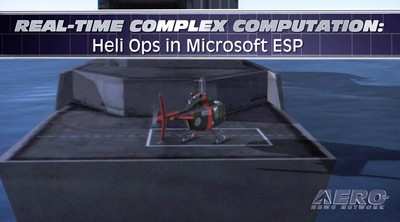
So... at the 2008 Interservice/Industry Training, Simulation and
Education Conference (I/ITSEC) last month, Aero-TV stood up and
PAID ATTENTION when we saw something done right there on the
convention floor that was intensely difficult to do... the complex
modeling of a Bell 206, following a moving ship on a waterway, and
the landing of the Bell on that ship. Think of all that this action
implies -- the modeling of the helo, the boat, and the conditions
around and caused by the interaction of the helo with the in-motion
ship.
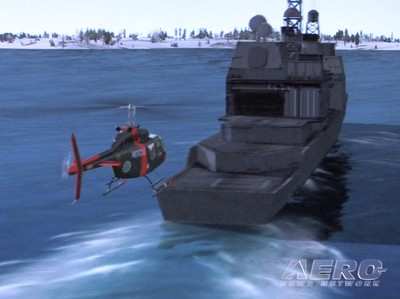
(I try to think of that and then remember how I struggled
through Pre-Calc... and get a headache. -- Jim Campbell-E-I-C)
The area that we watching this miracle performed sat under a big
Microsoft sign... where Microsoft's ESP technology (and the
upcoming ESP 2) were on display, and demonstrating advanced
capabilities for a critical audience.
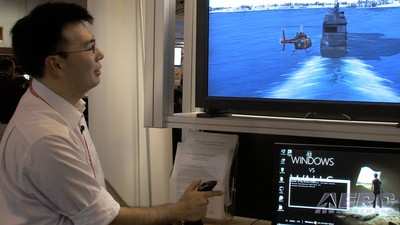
In the case of ESP 2, it was the first time new capabilities of
the next version of the Microsoft ESP visual simulation software
development platform were to be seen, publicly. Microsoft notes
that ... "since the debut of Microsoft ESP earlier this year,
significant progress has been made working with partners and the
academic research community to bring the power of immersive
simulation to the desktops of defense and civilian agencies for
mission rehearsal, interactive training and decision support.
Growing interest in Microsoft ESP can be attributed to the cost
advantages and productivity gains realized from creating
mission-critical visual simulation solutions on a common software
development platform that supports Windows-based commercial
off-the-shelf (COTS) hardware and software."
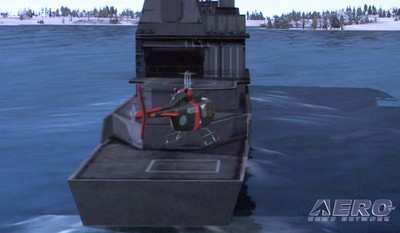
Among the sim demonstrations at I/ITSEC 2008 (using Microsoft's
ESP), we observed...
- A Northrop Grumman simulator demonstrating virtual landing of
an F-18 Hornet on the CVN-21 “carrier of the future”
incorporating Microsoft ESP, Virtual Earth and Microsoft Surface
with Northrop Grumman’s Command and Control Mission Rehearsal
(C2MR)
- A helicopter flight simulator revealing Microsoft ESP’s
version 2.0 multi-channel display capabilities across three large
screens
- The F-16 cockpit trainer from Flight-Dynamix demonstrating the
integration of Microsoft ESP version 1.0 into an existing custom
hardware simulation solution
- And THE kicker -- A demonstration produced by
the School of Engineering Sciences at the University of
Southampton, United Kingdom, made using Microsoft ESP and Windows
HPC Server 2008, showing a helicopter landing on a moving ship. A
white paper, “Real-Time Computational Fluid Dynamics for
Flight Simulation,” describing the process used by the
scientists has been published by the I/ITSEC conference.
“It is important to be able to apply a variety of
techniques in order to accurately solve challenging problems such
as a helicopter interacting with a ship air wake,” said Dr.
Kenji Takeda, senior lecturer in the School of Engineering Sciences
at the University of Southampton. “Improvements in
price/performance of technologies such as Microsoft ESP and Windows
HPC Server 2008 are helping to make such breakthroughs
possible.”
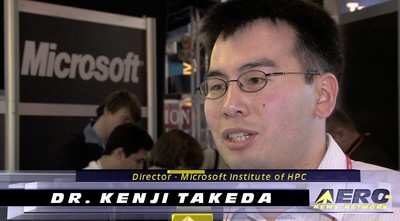
Breakthroughs, indeed... we were impressed... and if we
understood more of the complex math and modeling necessary to
accomplish such a task, we have little doubt that we'd be even more
so. Well done, folks.
 Aero-News: Quote of the Day (07.11.25)
Aero-News: Quote of the Day (07.11.25) ANN's Daily Aero-Term (07.11.25): Permanent Echo
ANN's Daily Aero-Term (07.11.25): Permanent Echo ANN's Daily Aero-Linx (07.11.25)
ANN's Daily Aero-Linx (07.11.25) NTSB Final Report: Schweizer SGS 2-33A
NTSB Final Report: Schweizer SGS 2-33A NTSB Prelim: Aeronca 7AC
NTSB Prelim: Aeronca 7AC







